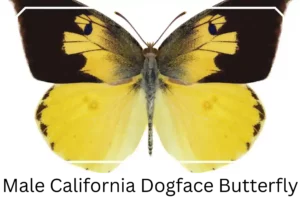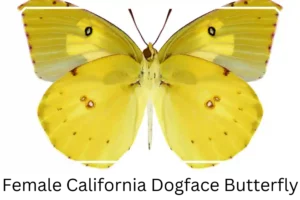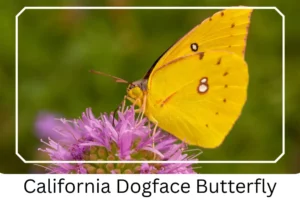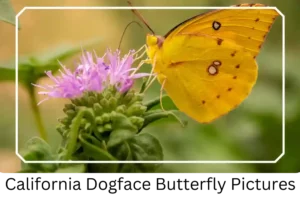California Dogface (Zerene eurydice)
The California Dogface butterfly, a jewel amongst the Pieridae family, exemplifies nature’s exquisite artistry with its vibrant hues and unique patterns. Native exclusively to California, this butterfly symbolizes the ecological richness and biodiversity of the region. Its presence not only adds color to the natural landscapes but also plays a significant role in the local ecosystem.
Scientific Classification
- Family: Pieridae
- Genus: Zerene
- Common names: Dog-head Butterfly
- Scientific Name: Zerene eurydice
Overview
Characterized by its bright yellow and orange coloration, the California Dogface butterfly stands out as a fascinating subject for both enthusiasts and researchers. This butterfly, with its distinct appearance and behaviors, offers a captivating glimpse into the complex interactions within habitats it inhabits. The following sections delve into the lifecycle stages, physical characteristics, and interesting facts about this remarkable species, providing a comprehensive understanding of its significance.
Description and Identification
Caterpillar
The California Dogface butterfly’s caterpillar phase showcases a bright green body adorned with horizontal white to pale green stripes, sometimes bordered in black. This vivid coloration serves as a defense mechanism, blending seamlessly with foliage to evade predators.
Pupa
Transitioning from larva to adult, the pupa maintains the bright green hue for camouflage. Suspended by fine silk threads, this chrysalis stage is crucial for development, lasting approximately two weeks before emerging as a butterfly.
Adult Butterfly
Sexual Dimorphism: A striking feature of the California Dogface butterfly is the sexual dimorphism observed between males and females. Males display a more vivid color palette on their wings compared to the females, which have a uniform pale cream coloration with a distinctive black dot on each wing.
Color and Appearance: Upon spreading their wings, males reveal an iridescent bluish-black color on the dorsal side of the forewings, complemented by peach to pinkish markings. The hind wings are a mixture of orange and sulfur-yellow. The ventral sides mirror the dorsal patterns but are slightly paler.

 Average Wingspan: The wingspan of the California Dogface butterfly ranges from 2 to 2½ inches (5.1 – 6.3 cm), allowing for agile and rapid flight.
Average Wingspan: The wingspan of the California Dogface butterfly ranges from 2 to 2½ inches (5.1 – 6.3 cm), allowing for agile and rapid flight.
Flight Pattern: Known for their swift flight, these butterflies are elusive and challenging to approach, especially when not feeding on flower nectar.
Eggs
The egg stage is as unique as the butterfly itself, with eye- or paddy-shaped eggs exhibiting a yellowish to bright orange hue, laid individually.
Quick Facts | |
| Distribution | Exclusively found throughout California |
| Habitat | Prefers foothill regions, chaparral, oak, or coniferous woodlands |
| Predators | Includes birds, frogs, toads, snakes, lizards, ants, wasps, etc., with butterfly eggs targeted by smaller predators |
| Host Plants | Primarily False Indigo (Amorpha californica) |
| Adult Diet | Primarily flower nectar |
How to Identify California Dogface?
Identifying the California Dogface butterfly involves looking for specific markers in each life stage. For the caterpillars, search for the distinctive bright green body with horizontal stripes. The pupa stage is also green, making it blend in with leaves. Adult butterflies can be identified by their wingspan and the distinctive color patterns; males with their iridescent and colorful wings, and females with their pale cream wings and black dots. Observing these butterflies in their natural habitats, particularly around their host plant, False Indigo, can aid in identification. Their rapid flight and preference for purple flowers are also telltale signs of their presence.
Did You Know?
- The California Dogface butterfly has been designated as the state insect of California since 1972, marking a first in the U.S. for recognizing a state insect.
- Capturing a photograph of these swiftly flying butterflies with open wings presents a notable challenge for enthusiasts and photographers alike.
- The nickname “dogface” derives from a wing pattern in males resembling a dog’s head silhouette, with some seeing a poodle’s face.
- In 1977, the U.S. celebrated this butterfly with a 13-cent postal stamp, a specimen of which resides in the National Postal Museum.
- These butterflies show a particular attraction to purple flowers, which can be used to attract them for observation or photography.
Conclusion
The California Dogface butterfly is more than just a state symbol; it’s a testament to California’s diverse and vibrant ecosystem. Through understanding and appreciating its life cycle, habitat, and behaviors, we gain insights into the broader ecological web of life. This butterfly not only captivates with its beauty but also serves as a reminder of the importance of conservation efforts to protect our natural world. Whether you’re a seasoned entomologist or a curious observer, the California Dogface butterfly offers endless opportunities for discovery and wonder.
California Dogface Pictures

Scientific Classification

- Family: Pieridae
- Genus: Zerene
- Common names: Dog-head Butterfly
- Scientific Name: Zerene eurydice





